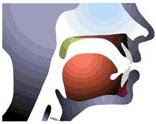
Basic Emphasis Pattern: Structure Words, Part 3
Reducing structure words even more: The reduced can and the silent H
The reduced can
The word “can” can also be reduced to /kʰʌ:n/. The vowel in can is reduced to schwa, but this does not happen in the word can’t, in which it is pronounced as a diagraph: /kʰænt/.

Examples:
Ø John can write very well.
/dʒa:n kʰʌ:n rayt ’vɛrɪ wɛ:ǝl/
Ø John can’t write very well.
/ dʒa:n kʰænt rayt ’vʌrɪ wɛ:ǝl /
Take turns with a partner reading the following sentences. Student 1 reads either (a) or (b). Student 2 answers.
| STUDENT 1 | STUDENT 2 |
| 1. a. John can write very well. b. John can’t write very well. | a. Yes, I agree. b. That’s unfortunate. |
| 2. a. Can you go tonight? b. Can’t you go tonight? | a. Yes. I finished my work. b. Unfortunately, no. |
| 3. a. The audience can hear the speaker. b. The audience can’t hear the speaker. | a. That’s good. b. That’s terrible! |
| 4. a. We can always eat before class. b. We can’t always eat before class. | a. Yes, I prefer that. b. No, sometimes not. |
| 5. a. Did you say they can come? b. Did you say they can’t come? | a. Yes, it’s possible. b. It’s impossible. |
| 6. a. The Johnsons can afford the trip. b. The Johnsons can’t afford the trip. | a. Oh, good! b. That’s too bad. |

The silent H
Pronouns are usually reduced so much that words like he, him, her, hers, his, and them lose the beginning /h/-sound. (In the case of them the /ϴ/-sound is also dropped.)
This rule only applies to these words in any position within the sentences except at the beginning of them.

Examples
| Written from | Slow, full | Fast, reduced |
| Is he? | /ɪ:z hiy/ | /’ɪ:ziy/ |
| Give her | /gɪ:v hʌr/ | /’gɪ:vǝr/ |
| Would he? | /wʊ:d hiy/ | /’wʊ:ɾiy/ |
| Sell them. | /sɛ:ǝl ðɛ:m/ | /’sɛ:ǝlɛ:m/ |
As you may have noticed with these examples, linking is especially important with the silent H.

Take turns with a partner reading the following sentences. Student 1 reads either (a) or (b). Student 2 answers.
| Student 1 | Student 2 |
| 1. a. Did he go? b. Did she go? | a. No, he didn’t. b. No, she didn’t. |
| 2. a. Is her work good? b. Is his work good? | a. Yes, she does well. b. Yes, he does well. |
| 3. a. Give him a message. b. Give her a message. | a. He isn’t here. b. She isn’t here. |
| 4. a. Did you take her pen? b. Did you take your pen? | a. No, it’s mine. b. No, I left it. |
| 5. a. Is this his apartment? b. Is this Sue’s apartment? | a. He lives across the street. b. She lives across the street. |
| 6. a. Is he busy? b. Is she busy? | a. No, he isn’t. b. No, she isn’t. |
| 7. a. Can he read? b. Can she read? | a. Yes, quite well. b. Unfortunately, no. |

Linking over the silent H

Practice the following dialogue.
| Stage Manager | Where’s our singer? |
| Assistant | I think he’s practicing, sir. |
| Stage Manager | But we need him on state now! |
| Assistant | Well, you know how nervous he gets. |
| Stage Manager | Did you tell him the concert’s about to start? |
| Assistant | It sounds like he’s practicing just as fast as he can. |

Read the following limerick.
A Train Ride
A singer once went to Vancouver,
Thinking the move would improve her.
But the trip was so long,
And her voice grew son long,
At Toronto they had to remove her.













